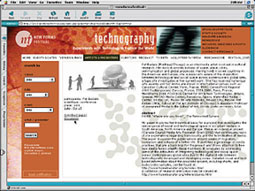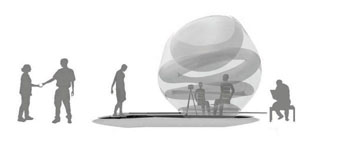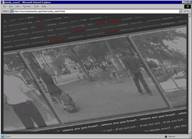Abstract:
Keywords: Introduction “Where are you from?” synthesises many of my explorations regarding translocality, the hybridisation of media, and the convergence of technological and social space in the urban environment. It received a Canada Council Media Arts Research Grant in 2002. The project is entwined with a set of existential concerns encapsulated in the title of Paul Gauguin's 1897 painting: Where do we come from? What are we? Where are we going? [1] It juxtaposes culture and technology to explore the boundaries between how we imagine the world and our place within it. Broadband and IP protocol will be used to explore aspects of globalization such as migration, nomadism, hybrid identities, language convergence, and electronic mediation. Video taped stories from transitional human subjects in six world cities will be Webcast Live during public performances. These testimonies will reveal notions of belonging. I frame the project around my personal geography in six cities: Montreal , Toronto , Chicago , Mexico City, Buenos Aires and Paris . These cities I have lived in occupy a position of centrality or periphery that are relative in the cultural universe. For example, Buenos Aires may be a center in the imagination of a migrant from Peru , but a periphery for a nomad/passer-by from Tokyo , itself a globalised center containing numerous local peripheries. I am interested in this intermingling of centers and peripheries as they relate to local and global environments. In the “Where are you from?” project, I seek to reveal these complex relationships through testimonies that integrate images of self and translocal experiences. The project creates communicational spaces in public urban locations where citizens-at-large will share personal stories. These will be broadcast Live on the Internet to viewers world-wide. I will launch conversations with a simple question that everyone can relate to: "Where are you from?" Through a system I have developed and tested during research interviews, I will involve participants in a conversation. Discussions will reveal where people come from and where they are going, presumably to seek a “better life”. The online environment will be a transcultural space of reception and exchange where viewers will not only see Live, video taped strangers telling stories on the Internet, they will also be able to participate by contributing a story of their own. The project converges the movement of populations and technologically mediated stories of these populations on the Internet. The aim is to explore cultural identity issues around notions of a “better life”. Locating culture The quest for a better life -- often located elsewhere -- is endemic of modern living where “home” is no longer a fixed place. In his book The Location of Culture , Homi K. Bhabha ( 1996) claims that: "It is the trope of our times to locate the question of culture in the realm of the beyond, ” [2] a word that marks progress by promising the future. Bhahba claims that for many, the promise of a better life allows for the re-definition of place and belonging in a hybrid site often located between cultural traditions and historical periods. Along similar lines, social anthropologist Arjun Appadurai ( 1996) views electronic mediation and migration as the most important factors defining today's global world. He claims that territoriality is replaced by translocalities, thanks to migrating peoples as well as to the electronically mediated movement of ideas, values, life-styles, and everyday lives that modify cultural spaces and cultural worlds. [3] My research interviews conducted between 2002 and 2004 in preparation for the Webcast, support Bhabha's and Appadurai's arguments by presenting “social actors” that negotiate hybrid identities and multilevel affiliations to home and nation.
The authentic lived experiences of speaking subjects have become central to recent ethnographic documentarists such as Janet Cool ( Home Economics , 1994), who rely on the immediacy of video to record social actors in contemporary cultural settings. Paralleling these intentions, “Where are you from?” aims to create a forum for discussion and an archive on contemporary notions of a “better life”. I incorporate techniques of investigation and recording used by visual ethnographers who acknowledge the importance of understanding people's cultural practice from within the everyday settings in which they take place. The project is inscribed at the cross-roads between current documentary ethnographic practices, and new media forms that rely on the technologies of our times in order to distribute Live video content through Webcasting. Mediated encounters and the networked city Webcasting uses the Internet and streaming media. It reflects yet another attempt in the development of video since the 1960s, to go beyond the usual broadcasting frame of television. Its basic concepts of simultaneity and translocality are not new. Artists like Kit Galloway and Sherry Rabinovich have explored real time-space that collapsed geographic boundaries since the 1970s with Live performances through Satellite. But, while Webcasting inherits a number of features from media such as television, it also departs from it in several ways. Because videos are distributed over the Internet, Webcasting has an entirely different production and distribution model than TV broadcasting. This subverts the power systems that underlie traditional broadcasting and provides the artist with a new platform for the free distribution of video content. In this sense, it allows for the re-appropriation of personal power within the context of the public sphere and the dissemination of a more eclectic range of views. These factors transform how one produces and exchanges knowledge. Furthermore, Webcasting can depart from the one-way delivery characteristic of traditional broadcasting. It can be interactive and participatory by establishing a two way systems of communication through Webconferencing, or by creating a Web space for image and text-based exchange where multiple threads from participants may coexist with the Webcast. Additionally, as bandwidth increases, one could explore the use of mobile, wireless devices with video-capture capabilities. In all of these instances, “virtual/real communication allows users to coexist/operate in several ‘worlds', to be ‘atHome' and at the same time itinerant and ‘distributed', offering alternative possibilities of presence and encounters.” (Paraguai / Pardo, 2001) [4] Connectivity has become the defining characteristic of our times, with nodes where electronic information flows, mobile bodies, and physical places intersect. William Mitchell (2003) postulates that in the past, “networks would mostly have been maintained by face-to-face contact within a contiguous locality - a compact, place-based community. Today, they are maintained through a complex mix of local face-to-face interactions, travel, mail systems, synchronous electronic contact through email, and similar media.” [5] He argues that increasingly, our sense of continuity and belonging derives from being electronically networked to widely scattered people and places. But, despite this claim about decentralisation, the city seen as brain or centralised communal ‘thinking space' still applies today, with the electronically wired city becoming a prosthetic extension of the human body. At the same time, one should not overlook the factors that enable the existence of these networks and people's access to them. There happen to be “particular combinations of fixed capital and human expertise that enable specific nodes within the global urban system, to play enhanced roles in the arena of cultural and economic production.” (Grandy, 2004) [6] That is to say, these electronically networked spaces -- the type of spaces that would enable my proposed Live Webcast -- have a geographic shape and result from a marketing synergy -- investments in specific places -- made by institutional and corporate interests that establish and maintain them. In addition, these entities can control the form these networks take, as well as their content. Electronically networked sites have a significant impact on public space. Wired as well as wireless-enabled urban spaces attract new social formations in specific physical structures: “stable institutions of hospitality” ( Raqs Media Collective , 2003) [7] such as universities and libraries, corporate and commercial spaces -- “Starbucks” being one example. These sites where technological and social space converge, contribute to the evolution of new communities, social systems and cultural meanings. But, while such electronically networked spaces in cities are quickly becoming a reality that affect small pockets within certain urban centers, one cannot ignore the real state of global media spaces: the fact that there exist devastating polarities and exclusions determined by economic disparity and access to technology in different cities in the world. The increasing divide between networked and non-networked spaces within cities as well as globally, will result in increasing polarities in social formations and cultural meanings. I witnessed such polarities in the process of conducting research for “Where are you from?” in Buenos Aires , Mexico City, Chicago , Paris , Montreal and Toronto . Interestingly, this project has brought to light the latent dichotomy in the relationship between social space and technology. I reiterate that the Live Performance/Webcast is based on the principle of connectivity and it seeks nodes where electronic information flows, hybrid mobile bodies, and physical places intersect. Webcasting has a production and distribution model conceptually adapted to these notions. It privileges the “authentic” experience characteristic of “real-time”. It favours the re-appropriation of the public sphere and the dissemination of varied and eclectic viewpoints to a broad audience. Most importantly, it embodies a different model for creating networks and collaborations, and therefore offers a viable alternative to dominant culture. But, what came to light out of my investigation in the above-mentioned cities, is the almost impracticality of the project across all borders. This is due to the disparities between electronically networked and non-networked public zones where the project could best intersect with geographic social space. Many of the disparities were related to economic issues and technical expertise in institutions of “hospitality”: cultural agencies, New Media Centers and Web Servers, who were for the most part, unable to embody an alternative position to dominant culture. Additionally, linkages between cultural organisms within cities as well as between different global sites that are available through the utopian logic of the “networked society”, linkages that favour reciprocity among local and remotely situated locations of cultural production, were in many cases absent, difficult to establish, or under negotiation. In their book Mapping Cyberpace , Dodge and Kitchin (2001) explain that a new urban spatial logic designed around electronic networks, has not replaced the old one around which many diverse social relations are built. In their words: “geography continues to matter – as an organising principle and as a constituent of social relations.” [8] I prefer to see the new spatial logic as an extension rather than as a replacement, as an amplifier that can generate new hybrid social spaces. In my project, I am interested in seeking out the urban locations where networked spaces, old and new, geographic and electronic, intersect. The problem is that, as it stands right now, the sites where technological space and face-to-face social space intersect in interesting ways, are still few and far between. Interests that do not attract a hybrid population across different constituencies and age groups, control these new spaces that are, in turn, scripted by the nature of the homogeneous inhabitants they attract. In the majority of the cities I researched, this audience tends to be predominantly young, affluent, male, and white. This is not at all the type of population that would shed light on cultural identity across differences of race, class, gender and historical traditions, as cited earlier in reference to Homi Bhabha's viewpoints. Cities continually adapt to the movement of ideas, values, life-styles, and influences that are brought in by migrants (people who immigrate), nomads (passers-by between places), locals who travel and return, by electronic mediation, and by an economic and technological synergy that takes advantage of urban resources. But, because technological development is linked to economic production, and because there exists an economic disparity between developing and developed cities, change happens at different speeds in different local and global zones. I have witnessed such a phenomenon while living in six cities in the Americas and Europe over a couple of decades, and confirmed it recently while conducting research for the “Where are you from?” project. Access to technology throughout global sites is dramatically unbalanced. This phenomenon is inhibiting the development of electronically networked spaces, as well as the social systems and cultural meanings that can evolve from them. Finally, transformations will inevitably happen, but they will happen at different rhythms, implicating initial polarities and exclusions. I think that one should take advantage of the fact that a new spatial logic is in the making and take measures to influence its shape by creating networks of communication where new and old forms and modalities can co-exist in diverse ways. These could be visible or invisible networks, small group or large group networks, linking geographic and electronic environments. Whatever their form or scale, I think that they would function more equitably if they embodied restorative communal strategies that circumvent established power relations. In spite of the impact of globalisation (and the electronically networked city is a contributing factor), old social networks around which the functioning of cities depend: community and its rules, its language, its exchanges, its behaviours, and its memories, can and should influence the way in that new electronic networks intersect with them. It is my belief -- and I do not think that this is an impractical utopian wish -- that the new spatial logic should be inclusive and hybrid, and should create a culture that people will want to be a part of because it is woven into the rhythm of the everyday, with its variability and plurality, respectful of the specific relationships between the local and the global that make up the cultural landscape of each place. References 1. Gaugin, P. 1897. Museum of Fine Arts , Boston , USA . 2. Bhabha, H. 1994. The Location of Culture , London and New York : Routledge, P. 1 3. Appadurai, A. 1996. “Modernity at Large”, Disjuncture and Difference in the Global Cultural Economy, Minniapolis and London : University of Minnesota Press, pp. 27 to 47 4. Paraguai, L. and Pardo G. 2001. Artistic Environments of Teleprescence on the WWW, Cambridge , Mass. : Leonardo, Vol. 34, Issue 5, MIT Press, P. 440 5. Mitchell, W. 2003. Me ++, Cambridge , Mass. : MIT Press, P. 17 6. Grandy, M. 2004. Cyborg Urbanization , London , UK : Department of Geography, University College London , P. 9 7. Raqs Media Collective. March 31, 2003. Nomadism and Routes. In: Translocations: A Conversation , Online Exhibition part of: How Latitudes Become Forms , Walker Art Museum , http://amsterdam.nettime.org/Lists-Archives/nettime-l-0303/msg00164.html 8. Dodge, M. and Kitchin R. 2001. Mapping Cyberspace, London and New York : Routledge, P. 14
Pat Badani (Montreal/Chicago) is an intermedia artist involved in cultural research. Her work examines notions of space, place, cities, communication and global processes. Having lived in seven countries in the Americas and Europe , she is especially aware of the disjunction between technological and social space across contemporary global sites, a topic she investigates in her current work. She has received a number of arts awards and her works are shown in international venues such as: Canadian Cultural Center, Paris, France; FRAC Corse (Fond Regional d'Art Contemporain) Corsica, France; ISEA 2000 , Paris, France; Medi@terra 2000 , FOURNOS Center for Art & New Technologies, Athens, Greece; MECAD Media Center, Barcelona, Spain; Watershed Media Center, Bristol, UK; Museo de Arte Moderno, Mexico City, Mexico. Pat Badani (MFA, School of The Art Institute of Chicago ) is Assistant Professor of Integrated Media in the School of Art , Illinois State University , USA . |
|||||



